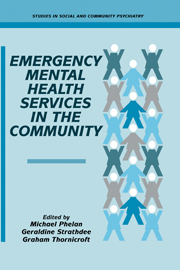Book contents
- Frontmatter
- Contents
- Contributors
- Foreword
- PRINCIPLES AND POLICIES
- 1 The scope and limitations of emergency mental health services in the community
- 2 Service models in emergency psychiatry: an international review
- 3 Users' perspective on emergency needs
- 4 Legal aspects of mental health emergencise
- 5 The economics of mental health emergency services
- 6 Suicide prevention
- 7 Using the crisis
- 8 Community assessment of crisis
- CHALLENGE OF IMPLEMENTATION
- Index
4 - Legal aspects of mental health emergencise
from PRINCIPLES AND POLICIES
Published online by Cambridge University Press: 28 October 2009
- Frontmatter
- Contents
- Contributors
- Foreword
- PRINCIPLES AND POLICIES
- 1 The scope and limitations of emergency mental health services in the community
- 2 Service models in emergency psychiatry: an international review
- 3 Users' perspective on emergency needs
- 4 Legal aspects of mental health emergencise
- 5 The economics of mental health emergency services
- 6 Suicide prevention
- 7 Using the crisis
- 8 Community assessment of crisis
- CHALLENGE OF IMPLEMENTATION
- Index
Summary
Mental health law: an introduction
This chapter describes the legal powers which professionals may use in the mental health ‘emergency’. The law is that in force in England and Wales and after outlining how this has developed, the various common law principles and statutory measures which may apply are presented. These may be used to restrain a person's behaviour, help secure an assessment of a person's condition or provide forced treatment in hospital. The chapter concludes with a brief examination of international trends in mental health law and some thoughts on future legal changes.
The development of mental health law can be seen as a convergence of two strands of legalism. The first sought to formulate principles and procedures to protect the public from the ‘insane’. The second attempted to protect both the ‘sane’ from unjustified detention and persons with a mental disorder from detention that is unnecessary. The law has also been concerned to define and protect the rights of citizens who have to have their liberty restricted due to their mental condition.
By the mid-nineteenth century, a system had emerged for dealing with mental illness which strongly mirrored the social class of the person affected. Upper classes were confined in licensed private institutions, middle classes in registered hospitals, whilst those whose families could not finance such confinement were found in the workhouse or in public asylums. The aims of the respective institutions were containment and isolation rather than cure or rehabilitation and the law reflected this.
- Type
- Chapter
- Information
- Emergency Mental Health Services in the Community , pp. 61 - 80Publisher: Cambridge University PressPrint publication year: 1995

